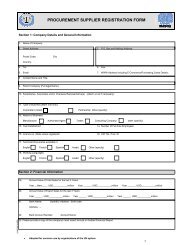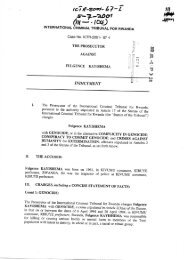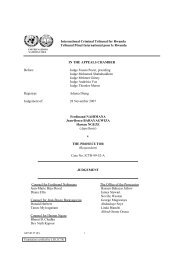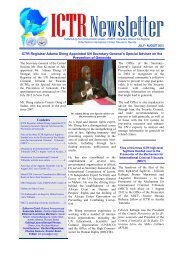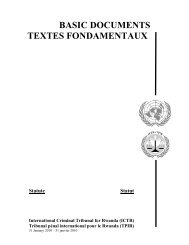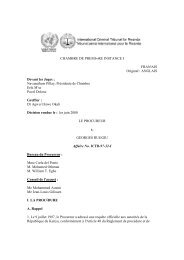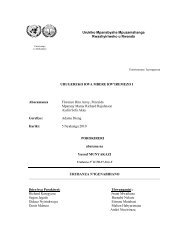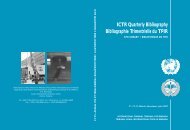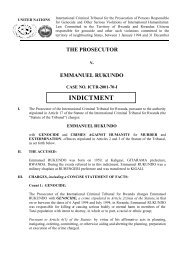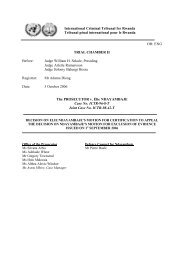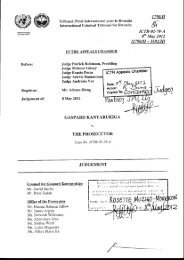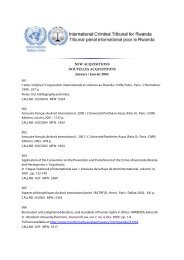Kanyarukiga - JUDGEMENT AND SENTENCE - Refworld
Kanyarukiga - JUDGEMENT AND SENTENCE - Refworld
Kanyarukiga - JUDGEMENT AND SENTENCE - Refworld
You also want an ePaper? Increase the reach of your titles
YUMPU automatically turns print PDFs into web optimized ePapers that Google loves.
Judgement and Sentence 1 November 2010<br />
instigating, ordering or aiding and abetting the commission of genocide by one or more other<br />
persons, the Prosecutor must establish that the accused’s acts or omissions substantially contributed<br />
to the commission of acts of genocide. 1748<br />
636. In the absence of direct evidence demonstrating the perpetrator’s specific intent to commit<br />
genocide, such intent may be inferred from his statements or other circumstantial evidence. 1749<br />
Factors that may enable a Trial Chamber to infer the perpetrator’s genocidal intent include the<br />
general context, the perpetration of other culpable acts systematically directed against the same<br />
group, the scale of atrocities committed, the systematic targeting of victims on account of their<br />
membership in a particular group or the repetition of destructive and discriminatory acts. 1750 The<br />
perpetrator need not be motivated solely by a genocidal intent and having a personal motive will not<br />
preclude such a specific intent. 1751<br />
637. The Amended Indictment charges <strong>Kanyarukiga</strong> with genocide for killing and/or causing<br />
serious bodily or mental harm to members of the Tutsi ethnic group. Trial Chambers have defined<br />
“killing members of the group” as requiring a showing that the principal perpetrator intentionally<br />
killed one or more members of the group. 1752 “Serious bodily or mental harm” is not defined in the<br />
Statute and has not been squarely addressed by the Appeals Chamber. 1753 The Trial Chambers,<br />
however, have largely adopted the following definition from Kayishema and Ruzindana: “‘causing<br />
serious bodily harm’ … could be construed to mean harm that seriously injures the health, causes<br />
disfigurement, or causes any serious injury to the external, internal organs or senses.” 1754 Typical<br />
examples of serious bodily harm include torture and rape. 1755 With respect to “serious mental<br />
harm,” several Trial Chambers have said that it refers to “more than minor or temporary impairment<br />
of mental faculties.” 1756 However, there does not appear to be any jurisprudential foundation for this<br />
Judgement and Sentence (TC), 13 December 2005, para. 412; Prosecutor v. Seromba, Case No. ICTR-2001-66-I,<br />
Judgement (TC), 13 December 2006, para. 319.<br />
1748 Nahimana et al., Judgement (AC), para. 492.<br />
1749 Kayishema and Ruzindana, Judgement (AC), paras. 158, 159. See also Seromba, Judgement (AC), para. 176;<br />
Gacumbitsi Judgement (AC), paras. 40-41; Rutaganda Judgement (AC), paras. 525, 528; Krstić, Judgement (AC), para.<br />
34; Semanza, Judgement (AC), para. 262, quoting Jelisić, Judgement (AC), para. 47.<br />
1750 Semanza, Judgement (AC), para. 262, quoting Jelisić, Judgement (AC), para. 47. See also Rutaganda, Judgement<br />
(AC), para. 525.<br />
1751 Simba, Judgement (AC), para. 269; Jelisić, Judgement (AC), para. 49. Accord Niyitegeka, Judgement (AC), para.<br />
53.<br />
1752 See, e.g., Ntawukulilyayo, Judgement (TC), para. 452; Bagosora et al., Judgement (TC), para. 2117; Simba,<br />
Judgement (TC), para. 414; Semanza, Judgement (TC), para. 319. See also Kayishema and Ruzindana, Judgement<br />
(AC), para. 151 (“[I]f the word “virtually” is interpreted in a manner that suggests a difference, though minimal,<br />
between the two terms, it would construe them both as referring to intentional but not necessarily premeditated murder,<br />
this being, in its view, the meaning to be assigned to the word “meurtre.”).<br />
1753 See Seromba, Judgement (AC), para. 46.<br />
1754 Kayishema and Ruzindana, Judgement (TC), para. 109. See Ntawukulilyayo, Judgement (TC), para. 452; Bagosora<br />
et al., Judgement (TC), para. 2117; Prosecutor v. Ntagerura et al., Case No. ICTR-99-46-T, Judgement and Sentence<br />
(TC), 25 February 2004, para. 664; Semanza, Judgement (TC), para. 320.<br />
1755 Seromba, Judgement (AC), para. 46.<br />
1756 See, e.g., Ntawukulilyayo, Judgement (TC), para. 452; Rukundo, Judgement (TC), para. 260; Bagosora et al.,<br />
Judgement (TC), para. 2117; Ntagerura et al., Judgement (TC), para. 664; Prosecutor v. Kajelijeli, Case No. ICTR-98-<br />
44A-T, Judgment and Sentence (TC), 1 December 2003, para. 815; Semanza, Judgement (TC), para. 321.<br />
The Prosecutor v. Gaspard <strong>Kanyarukiga</strong>, Case No. ICTR-2002-78-T 157



